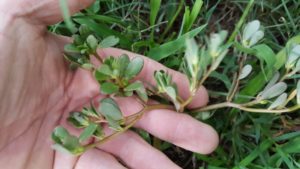Foraging For Edibles – Purselane
I get commissions for purchases made through links in this post. View our Affiliate Disclaimer.
Purselane is another important plant to learn when foraging for edibles! This succulent annual plant thrives in poor soil and can be found in many countries around the world. Originally from India, Purselane (Portulaca oleracea), has been spread far and wide as an edible plant.
In most countries, however, it is considered a weed, but that does not detract from its usefulness!
How To Identify Purselane
Purselane has a thick, slightly red colour stem, and succulent (fleshy), spoon-shaped green leaves. The flowers are yellow and occur either as a single flower, or in clusters at the end of a stem. The flowers are relatively small, about 5mm in diameter and have 5 petals. It is a trailing plant that can grow up to a height of 10cm.

The flowers usually open for a few hours on bright sunny mornings, and then close again later in the day. Each flower becomes a small seed capsule, which when ripe, splits around the centre. This releases the many tiny black seeds.
Purselane is often called duckweed, or cat’s tongue, or by the first part of its scientific name, Portulaca.
Warning!
There is a similar look-alike plant, the Hairy-Stemmed Spurge (Euphorbia vermiculata), which is poisonous. This plant is distinguished by a milky sap, which can be seen if you squeeze the stem. It also has fine hairs on the stem, whereas purselane does not.
The Health Benefits of Purselane
This amazing garden weed has many characteristics that can benefit our health!
- It is very low in calories and fats
- It is rich in dietary fibre
- Contains vitamin E and C
- Rich in minerals (potassium, calcium, magnesium, carotene , riboflavin, and phosphorus)
- Contains more omega-3 fatty acids than any other plant (helps prevent illnesses including heart disease, cancer and Alzheimer’s disease)
- It is healthy for our skin, urinary system and digestive system
- Has antibacterial and detoxifying properties
- Lowers cholesterol due to high pectin levels in purselane
How To Use Purselane
The edible parts of the plant are the leaves, stems and flower buds, which can be eaten either raw or cooked.
Purselane is surprisingly tasty for a plant considered to be a weed!
Purselane has a pleasant crunch with a slightly tangy lemon flavour! Some people have likened the taste to watercress.
Some suggested uses for purselane are:
- Eat as a cooked vegetable (lightly steamed or stir fried)
- Use fresh in a salad
- Add to stews and soups
- Add to pesto – adds zesty flavour and reduces amount of oil required
- Put on sandwiches with cold meats
The nutritional value of this plant definitely elevates it above the status of an undesirable weed!
Go foraging for this edible in your back yard! You may not even know that this nutritious plant was growing unnoticed in your garden all along!
You May Also Like ….
Take a look at our post on another wild edible – Wood Sorrel, and our post on Guidelines for Foraging for Wild Edibles
Get more posts like this
Subscribe to our mailing list and get interesting homesteading and green living info and updates to your email inbox.
Thank you for subscribing.
Something went wrong.







